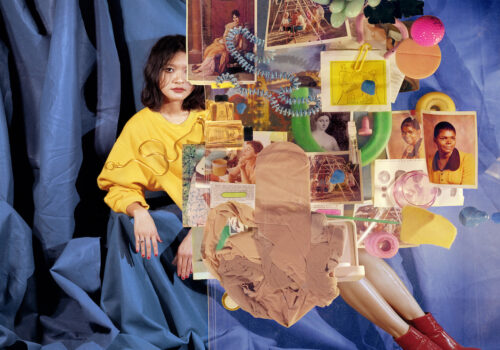Examining Narrative from the Inside Out, Censorship in the Art World, and Re-looking at Formulated Imagery: Sara Cwynar in conversation with Katelynn Dunn

February 03, 2021
by Katelynn Dunn
Finding Pleasure, Joy, and Comfort within the Playroom: Kathy Cho in conversation with Clae Lu

May 25, 2023
by Kathy Cho
This is an interview by curator Kathy Cho with artist Clae Lu, recipient of the New York Community Trust’s Edward and Sally Van Lier Fund residency at ISCP. Considering the artist’s practice holistically, the conversation brings insight to Lu’s research and community engagement, both of which deeply inform the work that was developed during their time as artist-in-residence. This exchange is published as an accompaniment to the solo exhibition Clae Lu: Playroom, on view at ISCP from February 28 to June 9, 2023.
Kathy Cho (KC): How did you approach your residency and decide what to focus on?
Clae Lu (CL): I was accepted into this residency program as I was exploring how to take a sabbatical from my corporate job in order to take care of my mental health. I decided I would make this residency my only focus for six-plus months, to invite play, curiosity, and rest as the center of my life. So the first few months were a mental challenge of unlearning productivity and relearning what creating from a place of curiosity would look like.
I applied with a focus around uncovering what queer stories and narratives exist in Chinese traditional folklore. I was largely inspired by 梁山伯与祝英台 (Liángshān bó yǔ zhù yīng tái, or Butterfly Lovers), which is a queer love story from the Jin dynasty that has been a foundation for many different historical social and political movements, as well as queer theory in China. It became a jumping-off point to explore what queering my relationship to the 古筝 (gǔzhēng) would look like, and what making my own music would sound like.
While creating space in my studio for play, curiosity, and rest, I also reflected on the communal spaces I’ve built and been part of over the years. The majority of my work is rooted in community building, especially around celebrating the gray zone between platonic, romantic, and familial relationships. In creating this mental space in my studio, I picked up drawing and painting again as a way to celebrate chosen family and food!
KC: What are some ongoing threads of research and practice that inform the works you produced during your residency?
CL: I haven’t always had the words for this, and I’m still finding the words. But getting in touch with and trusting in our innate sense of purpose as queer, trans people of color is one of the biggest things I’ve been tapping into. I’ve been following this thread of storytelling and placemaking as a native Queens, New Yorker, looking at the ways sound connects us to place.
When Alison Kuo, the program director at ISCP, sent me this article on the politics of sound, I finally had words for a lot of feelings about why I gravitate towards Chinese folk music and non-Western sounds. I found it particularly interesting to think about the kinds of sounds we hear in our everyday surroundings: languages, songs, nature sounds, everything that makes up the “white noise” of our lived experience. And these can change, too, like how our neighborhoods change, how gentrification will change the sounds of a place. Which also begs the question, what sounds have been erased or excluded?
A lot of my background and interests come from a place of queering my life, queering social constructs, and realizing that everything around us was made up by someone, by people who deemed certain things more important than others. So when I realized I could do the same, I decided to prioritize things that bring me joy and pique my curiosity, things that often weren’t taught in school or accessible through mass media.
The more I questioned and queered things around me, the more I realized there is space for expansive exploration and creation. I’m currently in a hole of finding all kinds of zithers related to the 古筝, even really obscure ones within rural China. I am also finding other musicians and artists and exploring in the realms of folk/experimental music, meditative sound, ambient music—connecting the varied parts of ourselves as artists, musicians, queer and trans Asians of the diaspora.
KC: Did the residency provide a different way of approaching your 古筝 practice, compared to your previous performances?
CL: This residency was a great opportunity to fully focus on exploring my relationship to the 古筝 more thoroughly and thoughtfully. Because this residency is fully funded, I decided to quit my full-time job. It was really helpful to have the time and support to freely play with both my instrument and all these concepts that had been brewing in my head. To finally have dedicated time, support, and space to actually implement them was really special.
Since 2018, I have been relearning songs I used to know really well, and oftentimes it was hard to balance that with my full-time job, part-time job, and other hobbies or freelance work. A lot of my performances during that time were taking folk songs I used to know and manipulating them as an excuse to relearn songs.
But with the residency, I got over the hump of trying to pick up old songs, and felt confident enough to deeply consider what kind of music I wanted to make. I found myself gravitating towards meditation and healing music. Especially when I sat with the concepts of Chinese folk music, such as the importance of letting sounds breathe, it began to align with music from sound baths and ambient sound I was researching. This research led to the beginnings of sound sketches that eventually became a soundtrack of experimental improvised songs that is part of the exhibition. It’s really special to have created an entire soundtrack of meditative, ambient songs with chosen family while we were also practicing rest, joy, and peace in our lives. This work also feels relevant as we’re still in the COVID pandemic, learning and unlearning structures that no longer serve us and how we can be more gentle with each other.
There are definitely more avenues I want to keep exploring with 古筝 folk music, folk music of other Asian cultures, experimental ambient music, and pop mash-ups! I’m glad I was able to put energy towards those dreams through this residency.
KC: How did your previous experience working administratively and within your communities/chosen family inform how you individually created work? How did it inform your decisions to collaborate on certain works?
CL: I spent over four years working as the residency manager at the W.O.W. Project, overseeing the storefront residency. It was a really special time and place for me, as I got to better understand a lot about the facets of my intersectional identities as a native New Yorker, a person of Chinese diaspora relating to the different Chinatowns in New York, as a queer and trans person, and a person who cares about intentional community building and the arts. Working with various artists throughout my time and also learning how the W.O.W. Project, amongst other community-based organizations, was thoughtful about their programming, really opened my eyes to how we can build with and within our communities, and the beauty and power of collective will. My time in that space reaffirmed my belief in collaboration and its importance in how we depend on and trust in one another.
Now my work, in whatever form it shows up as, is deeply rooted in collaboration and co-creation. During my residency, I picked up drawing and painting again and really enjoyed making drawings commemorating joy and gathering. A lot of that manifested as paintings and drawings of food, specifically gatherings of friends and chosen family over shared meals and occasions.
In the pandemic I was finding a lot of different artists online working on meditative healing music like Laraaji, Londrelle, and Bravespace (a project by the Smithsonian Asian Pacific American Center highlighting music created by Asian American women and nonbinary artists and musicians). I could tell there was a collective move towards slowing down, making space for kindness and grief to process our collective experience. It inspired me to create a playlist of improvised songs with my chosen sibling Ben Florencio. We had been supporting each other through a lot of emotional shifts through the pandemic, and spending time together in their home upstate inspired us to make space for experimental soundscapes that mimic breathing and dreaming.
KC: What threads are you excited to continue pursuing post residency?
CL: I’m excited to keep exploring creating ambient music with folk instruments and collaborating with other musicians and artists working in similar interests. I am really excited to have worked with Daria Garina on our public event as part of my show, which consists of Qigong breathing exercises paired with improvised 古筝 sounds. We invited a public audience to experience this and also have a recorded version as a long-term, accessible resource. We also had a recent opportunity to present a shorter version of this event at the Queens Botanical Garden on May 13th as part of a lineup of queer and trans folks of the Asian diaspora celebrating our connection to heritage and culture through music, sound, and performance. That event was funded in part by the A4 What Can We Do? grant.
It’s especially heartwarming to me to be able to find spaces and opportunities where there is mutual interest in these sort of niche but spiritually important practices. So even if I go back to a day job or shift focus for a while, I’m really proud of having spent this time focusing on something so personally important, and being recognized for it too!
Image caption: Clae Lu, installation view of Playroom in ISCP project space, 2023. Photo by Shark Senesac
Image alt text: Person playing the Chinese zither